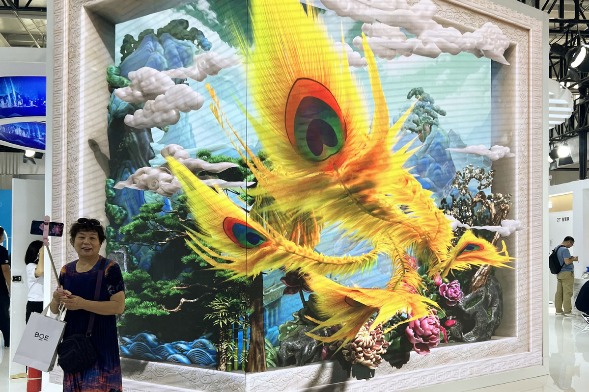
Visitors take selfies in front of a glass-free 3D screen at the BOE booth at the China International Fair for Trade in Services on September 5, 2023. [Photo/Xinhua]
As domestic tourism consumption demand continues to improve, China’s tourism market continues to grow alongside rising investment confidence.
During this year’s May Day holiday, 295 million Chinese tourists visited China domestically, up 7.6 percent from last year. Domestic tourism spending was RMB 166.89 billion ($23.47 billion), up 12.7 percent compared to the same period in 2023.
According to a report released by the China Tourism Academy (CTA), the confidence index for the cultural and tourism investment sector in the first half of this year rose 3.7% from the previous quarter to 144.1.
The application of technology, county-level travel preferences, and the integration of culture and tourism are shaping new trends in consumer experience.
Smart Tourism
Driven by new technologies, smart tourism has become a buzzword in China’s tourism industry, attracting both domestic and international travelers.
At Beijing’s Shougang Park, tourists are queuing up to enjoy immersive experiences through entertainment devices that utilize 5G, extended reality (XR) and virtual reality (VR) technologies.
The park, which was converted from a former steel mill, is now taking on a new look. By combining distinctive real-world scenery, lighting, and AR and VR technologies, the park’s immersive experience creates a new type of tourism consumption scene.
The Shanghai Astronomical Museum, a popular tourist attraction, visualizes little-known astronomical data and offers a fantastic immersive space adventure through XR, 3D movies and more.
During this year’s May Day holiday, the first wave of smart tourism immersive experience facilities announced by the Ministry of Culture and Tourism attracted more than 4.3 million visitors, with spending exceeding 220 million yuan.
Dai Bin, chairman of the CTA, said the application of new technologies such as 5G, artificial intelligence, big data and VR in the cultural and tourism sector is accelerating, and the industry shows broad prospects for high-quality development.
Country Craze
A growing preference for niche destinations and experiences among Chinese tourists is unlocking the huge potential of the country’s many lesser-known travel hotspots.
On the social media platform Xiaohongshu, tourists have uploaded more than 380,000 posts about county-level travel, revealing a county-level travel boom among the platform’s mostly young users.
Generally, tourists visit each county to taste local specialities, simply seek spiritual comfort, or check out special tourism IPs.
For example, Rongjiang County in Guizhou Province, the birthplace of the Village Super League, has attracted more than 400,000 tourists and generated tourism revenue of over 400 million yuan.
Similarly, tourists flocked to Zibo in Shandong province last year for its barbecue dishes, and this year to Tianshui in Gansu province for its malatang (a numbingly hot pot), after the two restaurants gained internet popularity for their dishes.
Li Xue, a researcher at the CTA, said that not only do counties boast beautiful scenery, but they also offer high-quality living spaces, which constitute the core competitiveness of the county-level tourism industry.
Integration of culture and tourism
The integration of culture and tourism combines cultural heritage, traditions, local flavor and tourism development to enrich the travel experience.
In Chaozhou city, Guangdong province, visitors can also sample traditional local dishes such as beef balls, crispy pancakes and sugar paintings at a special market and interact with local food artisans.
In Ordos city, Inner Mongolia Autonomous Region, tourists can not only purchase soft, fine cashmere products – a popular souvenir – but also take part in hands-on activities to decipher the production process.
The CTA forecasts that domestic trips in China will exceed 6 billion and tourism revenue will reach 6 trillion yuan this year, highlighting the bright prospects for technology-enabled tourism characterized by cultural integration and more personalized destination selection.
Dai said changes in tourists’ consumption demands have forced the tourism industry to focus on improving the modern tourism system and promoting high-quality development.

